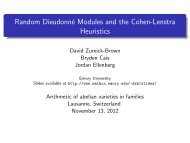alternative lecture notes - Rational points and algebraic cycles
alternative lecture notes - Rational points and algebraic cycles
alternative lecture notes - Rational points and algebraic cycles
You also want an ePaper? Increase the reach of your titles
YUMPU automatically turns print PDFs into web optimized ePapers that Google loves.
16. August 22 (Harpaz)<br />
Let K be a field. Let X be a K-variety. Let Γ = Gal(K sep /K). We constructed Et /K (X) ∈<br />
Pro(Γ- Set ∆op ). As we have seen, if π 0 (Map der (∗, Et /K (X))) = ∅, then X(k) = ∅.<br />
Definition 16.1. We will say that a simplicial set X is bounded if there is an n such that<br />
for all base<strong>points</strong> x <strong>and</strong> all N > n, we have π N (X, x) = 0. A pro-simplicial set is bounded if<br />
every simplicial set in the diagram is bounded (the n may depend on the simplicial set).<br />
Claim: There is a canonical functor X → X ♮ from Pro(Set ∆op ) to the full subcategory of<br />
bounded pro-simplicial sets. For each X, there is a morphism X → X ♮ with the property<br />
that for each bounded pro-simplicial set Y , there is a weak equivalence from the derived<br />
mapping space Map der (X ♮ , Y ) to Map der (X, Y ).<br />
Remark 16.2. Given a continuous Γ-action on X, there is a continuous Γ-action on X ♮ .<br />
Applying the functor twice yields an X ♮♮ weakly equivalent to X ♮ . From now on, we assume<br />
that this functor has been applied to all objects, so all pro-objects have been implicitly ♮-<br />
ized. So we work with Et ♮ /K(X), but from now on we drop the ♮. (This possibly weakens the<br />
obstructions.)<br />
So now we have an obstruction theory to the nonemptiness of<br />
X(hK) := π 0 (Map der (∗, Et /K (X)))<br />
with obstructions that live in<br />
Hcont n+1 (Γ, π n (Et /K (X)))<br />
For n = 1, we get<br />
Hcont(Γ, 2 π 1 (Et /K (X))) = Hcont(Γ, 2 π1 et (X))<br />
Claim: The n = 1 obstruction is exactly the nonsplitting of the Grothendieck short exact<br />
sequence.<br />
Last week, Tomer gave the example ∑ n<br />
i=0 x2 1 = −1 over R, for which there is a nonzero<br />
obstruction in H n+1 (Z/2Z, π n (Et /R (X))).<br />
There is a functor Y ↦→ P n (Y ) from Set ∆op to Set ∆op such that π k (P n (Y )) = 0 for<br />
k > n <strong>and</strong> π k (P n (Y )) ≃ π k (Y ) for k ≤ n. Then (Y ) ♮ = (P n (Y )) n∈N ; this is called the<br />
Postnikov tower. For each k, there is an isomorphism π k (Y ) ≃ π k ((P n (Y )) n∈N . Similarly,<br />
π k ((Y α ) α ) ≃ π k ((Y α ) ♮ ) := π k ((P n (Y α )) α,n ).<br />
In fact, (Y α ) ♮ is defined to be (P n (Y α )) α,n .<br />
Let K be a number field. Let X be a k-variety. We defined<br />
X(hK) := π 0 (Map der (∗, Et /K (X))).<br />
There is a map X(k) → X(hK) (not necessarily injective or surjective). Because of cohomological<br />
obstruction, this might not give an obstruction much stronger than the Grothendieck<br />
section obstruction, however.<br />
For each place v, consider f v : Spec K v → Spec K. Then f ∗ v Et /K (X) ∈ Pro(Γ v - Set ∆op ).<br />
(It turns out that this is the same as Et /Kv (X Kv ); this is a general property of pullback by<br />
field extensions.) We get<br />
X(K v ) → π 0 (Map der (∗, f v Et /K (X)) =: X(hK v ).<br />
37



